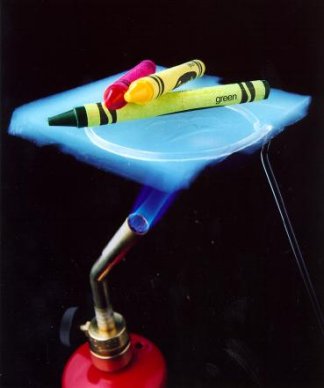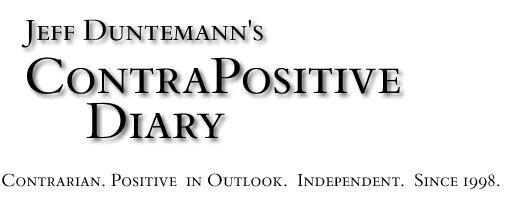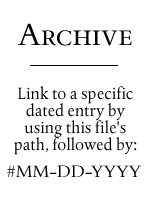|
|
|

|
 October
31, 2005: Scary as a Paradigm October
31, 2005: Scary as a Paradigm
You want scary? I'll tell you what's scary: A new programming paradigm.
We over-used that poor word back in the early 90s, when objects
were the scary new thing, but y'know, object-oriented programming
has nothing on server-side Web programming. In my loose moments,
I've been learning PHP. Neither PHP nor server-side Web programming
are new to the world, but they're certainly new to me, and I need
to get current with them.
PHP is nowhere near as convenient as Delphi or even Turbo Pascal
1.0. Programming in PHP is like standing across the street and yelling
code at a guy sitting in an upstairs room in somebody else's house.
If you're lucky, he has the window open and is listening. If he
doesn't hear you, he doesn't say anything. If you tell him something
incorrectly, he doesn't say anything either. PHP is a real quiet
guy.
Of course, my current method is optimally bad: I'm writing code
in Notepad, saving it out, bringing WSFTP up from the taskbar, clicking
Refresh, and then squitring the little .php file up to its directory
on my hosting service. Then I bring up Firefox from the taskbar
and click Refresh. My program runs. If there's something wrong with
the code, it dies and makes no sign. PHP does not believe in error
messages, or if it does, it doesn't see fit to send them down to
the browser.
So I'm interviewing PHP IDEs. So far I've tried EnginSite
and it's not bad, and tsWebEditor,
which is...so-so. Next up is mighty Zend,
which I think will win the pageant, for muscles if not for beauty.
I don't care if it's $240; if it does the job I'll pay it gladly.
Dreamweaver 3, after all, has served me well for almost seven years,
which is an eternity in this business. I have no stomach for programming
blind.
The paradigmatic shift in PHP, however, is the way it climbs down
into the cracks in an HTML markup file, like jelly creeps down into
the holes in an English muffin. At some point it's unclear whether
the jelly fills the holes in the muffin, or if the muffin fills
holes in the jelly. Still, HTML is full of holes, and PHP is gooey
as only an interpreted lanuage can be. What PHP can't do, HTML does.
What HTML can't do, PHP does. Together they're extremely effective.
My first difficulty is that I've gotten very rusty at manual HTML
markup in the last seven years. I used to do all my HTML by hand,
but Dreamweaver multiplied my productivity fantastically, and as
some of my readers occasionally fail to understand, I'm 53 and do
have a life. PHP being what it is, I've had to go back to my pre-1999
technique of drawing a Web page in Visio, deciding on all the various
attributes, jotting them in the margins of the diagram, and then
hand-compiling the diagram into an HTML table description, one subtag
at a time.
It works, and while it takes time, it's a good brushup. At the same
time I've been studying PHP I've also been studying the Apache Web
server and MySQL. The three work together so well that many people
consider them organs within a single organism, which in my own head
I've begun to call PASQL. (Has a nice ring to it, no?) PASQL has been
a lot of fun, as scary as the shift was initially. All I need now
is an IDE, and it will become tremendous fun. I may even finish
Aardblog. We'll see. Stay tuned.
|
 October
30, 2005: Odd Lots October
30, 2005: Odd Lots
- Bp. Sam Bassett of the Old Catholic Church wrote a
pretty eloquent response to my October
27, 2005 entry. I'm going to need a day or two to chew on
that before I can continue the discussion here, but it's very
much worth reading.
- Michael Covington sent me a link to an
outline of a paper he wrote about the relationship of mathematics
to Christian theology. Fascinating stuff; especially the quote
from Bishop Berkeley: "He who can digest a second or third
fluxion [derivative, from calculus] need not, methinks, be squeamish
about any point in divinity."
- Here's another
interesting idea in terms of Web marketing. Each of the million
pixels laid out on the page can be assigned an icon and a URL.
I followed some of the links just for curiosity's sake. (Most
were predictably sleazy or scammy-smelling.) Something like this
might act as the foundation for a bookmark management UI, where
each pixel is a link, and multiple pixels with the same link might
express an attribute like popularity, and the arrangement in the
grid where they fall in a 2-dimensional topic ontology of some
kind, like a 2-dimensional Dewey Decimal System. This is worth
a little more thought.
- As an exercise I installed DOS 6.22 in a VMWare Virtual Machine,
and then installed WordPerfect 4 in it, which I used as my primary
writing engine from 1985 to 1993. (I did it because the diskettes
will not last forever and I may save it all as a VM on CD.) Egad,
the thing has no user interface! The UI, in fact, was a clever
little die-cut template (now lost) that hugged your function keys
on the left end of a genuine PC keyboard. All the commands were
various combinations of Shift, Ctrl, and Alt with the function
keys. And there were other non-visual elements, like tapping a
function key twice and then an arrow key to go to the beginning
or end of the document. No pull-down menus. Zero. Zip. Lacking
the template, all of it had to simply be committed to synapses.
Howinhell did we do it?
|
 October
28, 2005: God and Calculus October
28, 2005: God and Calculus
Continuing yesterday's thread: Understanding God is a little (note
I said little) like understanding calculus. When you're five
years old, the word "calculus" and its underlying concept
are meaningless—but once you can count to ten, you've taken
a step. As you advance through school, you pick up an understanding
of other things—algebra, the Cartesian plane, trigonometry,
the idea of change itself—that are necessary to understanding
calculus. Most schoolhouse mathematics point toward calculus, but
calculus itself...now, that's difficult.
I remember trying to figure out calculus from a library book when
I was in high school, and hit a brick wall. I just didn't know enough
when I was 15. Too many of the pieces were missing. But then when
I was a college frosh at IIT in 1970, I had a superb teacher, and
I still remember the day when the the last of the missing pieces
fell into place, and the idea of integral calculus suddenly coalesced
up on Dr. Steuben's overhead slides. I'm not exaggerating when I
say that it was a kind of roaring mystical experience: Holy Mother
of God, I get it!
I flamed out of IIT after one painful semester, but later that
year when I was accepted into the English program at DePaul University,
one of the counselors asked me what elective I'd like to take my
first quarter there. I said "Calculus II!" with a sort
of geek excitement that English majors rarely express, and his response
was the first time (but not the last) that I heard someone ask,
"Well, why would you want to do that?"
Because I loved it, that's why. I took it, I aced it, and celebrated
by writing a calculus fantasy, which actually didn't turn out too
badly. (Those who have heard me talk about magic as "alternative
physics" may guess where I went with it.) However, my journey
into calculus (and all of higher mathematics) ended there. I took
it about as far as I could, given my circumstances and my temperament.
I understood then and I understand now that there are universes
of higher math that require an understanding of calculus. I recognize
that if I set everything else aside and really really worked
at it, I might make some progress in understanding them. I also
know that these dimly perceived universes of higher math make perfect
sense to those gifted with understanding them, even if I
don't personally understand them and never will.
There are some parallels to be drawn here. When I was five, God
was a Very Big Guy who listened to prayers. (After all, I had prayed
for my new puppy to get better when he was sick, and he did.) Over
the next fifteen years or so, I grew in rational and emotional maturity,
and my understanding of God became considerbly more complex and
subtle. At various points along the way, I recall these small epiphanies,
some of which actually were minor mystical experiences. But even
today, at 53, I'm wrestling with some of the pieces of The God Thing
that just don't fit together for me. Does that mean that it's meaningless?
No. It just means that I'm not yet wise enough to put it all together.
Just as it's possible to live a reasonably fulfilled life without
thinking about calculus, I think it's possible to live a comfortable
life without thinking about God. Most of my friends are atheists,
and it doesn't seem to bother them. They limit their lives to those
things that can be fully understood in the here and now. Most of
them are gentle, loving people, and to that extent, they understand
something of what God is about, just as one can ride an airplane
designed with calculus without even knowing the word.
My point is simply that understanding anything takes time and will,
and above all patience. So it was with calculus, and so it is with
God. Some of those things that don't make sense are what Catholics
call "mysteries," which means things that we don't understand
yet. (Quite a few others are simply mistakes.) And we don't
understand them yet because reason is simply not enough.
In fact, it's not even close.
More tomorrow.
|
 October
27, 2005: To What Extent Can God Be Understood? October
27, 2005: To What Extent Can God Be Understood?
I'm going to be on a panel at Windycon
in a couple of weeks, discussing whether science and religion are
necessarily in conflict. I've been reading and thinking and trying
to put together a reasoned position that can be stated in ten minutes
or less. That's not an easy thing to do.
My key difficulty is one that a lot of educated people confront
as they try to integrate their spiritual feelings with their earthbound,
rational conscious mind. It's about how to think about God. No,
scratch that; it's about whether you can think about God,
where "think" means come to some sort of coherent understanding
of what God is and what He wants.
Does God have to make sense? And if so, what kind of sense, and
how much?
People with stronger faith than I often miss the importance of
this question. Strong faith can pave over some of the cracks into
which pure rationality can fall. Those of us without strong faith
are left standing on the edge of the crack, trying to decide what
to do next.
You've heard me mull some of these issues before in this space:
What is the purpose of divine punishment (Hell) that allows no possibility
of rehabilitation? How can infinite punishment for finite transgression
be just? If some of the Church Fathers were wrong (Aquinas insisted
that women were defective men) or simply psychotic (Augustine claimed
that watching the damned roast in Hell was one of the perks of being
in Heaven) how can people like me interpret these foundational thinkers
of the Church? If the worldwide community of Christians (which includes
Western Catholics and the Eastern Orthodox) have been unable to
come to a common understanding of the Bible, how can I accept that
the Bible is inerrant? Questions like these have haunted me since
grade school.
We're not wrestling with gnats here. These are major issues, which
cook down to a series of Big Ugly Questions: Is God loving but utterly
ineffable? Is God comprehensible but a sadistic bastard? Is God
simply incoherent? Does God exist at all? How can I tell, and what,
in the end, is really on the table?
I'm out of time for this evening (and haven't posted anything in a
couple of days) so I'll come back to this issue tomorrow.
|
 October
26, 2005: Odd Lots October
26, 2005: Odd Lots
- The sheer audacity of the project is astonishing: To create
a cartoon summary of Star Wars Episode IV...in an animated
GIF. It worked. The GIF is here.
(Thanks to George Ott for the pointer.) Watch it. Then park it
in the corner of your screen and you can watch it again...and
again...and again...just like we watched the original film in
1977.
- Slashdot aggregated a
study finding that foreign workers admitted to the US to work
at high-tech firms under the H-1B program are paid significantly
less than Americans for the same work. So there's really no shortage
of high-tech workers. There's just a shortage of high-tech workers
willing to work as cheap as desperate foreigners will. A pox on
this program and all the politicians on both sides of their slutty
street who support it—and a double pox on companies who bribed
the politicians to allow it.
- I don't watch much TV, but Pete Albrecht pointed out a show
with some promise that might be characterized as Snopes
on video: Mythbusters,
on the Discovery Channel. Each episode attempts to verify
or puncture a popular urban legend. Read some of the episode summaries:
These goofnuts actually built a human-sized slingshot to see if
illegal aliens could launch themselves over border fences. (Did
you ever hear that urban legend? I didn't.) Hey, watching two
goofy-looking white guys launch themselves in a slighshot might
be
 worth
seeing. worth
seeing.
- This weekend will see the closest approach of Mars to Earth
during this opposition, and if the skies are clear I hope to have
the 8" scope out on the driveway Saturday night. Pete's been
taking photos as we ramp up to opposition, and the one shown here
might be his best yet. (For more superb Mars pictures using an
even smaller telescope, including one of a Martian dust storm,
see Michael
Covington's Web diary.) Another
chap actually photographed Phobos with a scope similar to
Pete's and posted an animation of Mars' vanishingly small minimoon
on his Web site.
|
 October
25, 2005: Colorado Springs Fall Colors October
25, 2005: Colorado Springs Fall Colors

Last week, Carol and I went out and spent an hour
trying to capture the fall colors here on the slopes of Cheyenne
Mountain. For whatever reason (a hot, wet summer?) I don't remember
them being anything close to this vivid the two previous autumns
we've lived here.
As good as it is, the photo above doesn't quite capture
the sight: Scrub oaks, aspens, and poplars in yellows, reds, and
a few laggard greens rolling uphill until the pines take over at
about 7,000 feet. Carol and I grew up with fall colors, of course,
but we had lived for 13 years in a place where fall brought nothing
but blessed relief from triple-digit temps. It's good to be back.
As I said last winter, it's so beautiful here that I
don't even mind shoveling snow!

|
 October
24, 2005: WiMax vs. Cells for Digital Radio October
24, 2005: WiMax vs. Cells for Digital Radio
Harry Helms, who writes the marvelous Future
of Radio blog, suggested that it will be the cell carriers,
rather than WiMax startups, who will be the digital broadcasters
of the future. (See my entry for October 18,
2005.) Harry thinks that cell phones will be the new receiver
of choice for everything—radio, video, whatever. Well, if it
were just a question of the compentency of the platform, I'd almost
agree. Certainly just about everybody has one of the damned things
in their pockets these days. Problem is, we in the US seem to come
in dead last in terms of innovative cell tech (I don't use the confusing
term "mobile" for cellphones, nor—God help us—"wireless")
especially compared to Asia. I have a very capable phone, but the
carrier will do almost anything to keep me from connecting it to
my computer and playing around with its advanced features. Furthermore,
the audio quality is still hideous, and this is what, 2005? I've
given up on flying cars, but sheesh, I'd have expected CD-quality
cellphone communication by now.
The problem is not the phones. The problem is the freak show of
cowards, dummies, yes-men, and crooks who run our cell carriers.
If they can't charge 25c per text message (or $2 per song) I don't
think they'll play. They're telephone companies, not broadcasting
companies, and the whole broadcasting business model goes down their
throats sideways. I won't say it'll never happen, but I don't think
the cell carriers will do it first.
Much depends on how 802.16e mobile WiMax comes in with respect
to battery draw. My early experience with Wi-Fi was that it is a
huge power hog, and while the newer hardware does better,
radio communication requires RF energy, which requires electricity.
If WiMax is a power hog, it won't be adopted in cell phones any
time soon. It's not like radio broadcasting, in that the WiMax mobile
unit has to be able to reply via radio to the WiMax base.
WiMax in auto radio/car computers makes more sense, since there's
a lot more power to draw on. How well it grafts into cellphones and
PDAs remains to be seen, at least near term. (The more interesting
possibility is a WiMax-equipped IPod, but that's a discussion for
another time.) I think that small tech companies will be the ones
who take WiMax and do innovative things with it. Once the cowboys
work the bugs out and start raking in cash, the cell carriers may
buy them out, but the arrow-averse carriers themselves are unlikely
to be the pioneers.
|
 October
23, 2005: Stars Orbiting Our Own Big Black Hole October
23, 2005: Stars Orbiting Our Own Big Black Hole
I get a fair number of links pertaining to astronomy here, from
Pete Albrecht and Frank Glover especially, but earlier this evening
I read one on Slashdot that spun my head around. Read
the article to see what we're dealing with here, but above all
else download and view the
composite photo animation, which captures 12 years of stellar
motion among the stars closest to the center of our own galaxy.
Using infrared photography and probably some other tricks I've
never heard of, those clever Europeans at ESO
have managed to photograph stars orbiting around what is almost
certainly a supermassive black hole at the center of our galaxy.
One star in particular roars down to within 17 light hours
of the singularity. (This may become the 21st century definition
of "brinkmanship.") Run it a few times, and note the whip-crack
effect on S2's orbit.
It's amazing enough that they can actually see all the way
down there (it's 26,000 light years away, to begin with) considering
the immense quantity of interstellar dust and other astrocrap lying
between us and the black-hole action. But to be able to plot such
extreme orbits around something that may have the mass a million
times that of our own Sun just boggles the mind.
The data ESO gathered may help a great deal in determining the mass
of the black hole, since there's now very little else that we can
postulate those stars to be orbiting. We'll never see the hole, of
course, but what would be absolutely incredible would be to watch
a star torn up by tidal forces before it vanishes into the hole. I'm
sure all eyes are going to be on this thing from here on out, and
if S2 decides to buy the farm, we'll see it. Maybe not this year,
and maybe not during my lifetime, but sooner or later...crunch!
|
 October
22, 2005: VMWare's Virtual Machine Player October
22, 2005: VMWare's Virtual Machine Player
I've spent some time with VMWare's newly released free
runtime module (they call it a "player") for virtual
machines created with VMWare Workstation. Very impressive.
I took several VMs that I had created up here and piped them down
to my 1.7 GHz Xeon downstairs. I'm very glad I have 100Base-T in
the walls; this amounted to 15 GB of data. VMs are not small
things.
Every VM that I copied down there loaded and ran perfectly over
the player. The response wasn't as crisp on the Xeon as it is up
here, but the Xeon is much slower and has less than half the memory.
I will probably try to run the same VMs on my creaky 550MHz Dell
Dimension, but I don't expect it to work very well. VMs need cycles
aplenty, and mondo RAM. Actually, the main problem with the Dimension
is that my VM files would occupy about 2/3 of the entire capacity
of the hard drive!
I have only one gripe, but it's a big one: The player apparently
doesn't allow you to load a snapshot. You boot a VM and it comes
up without anything running. Not being able to load snapshots really
cuts back on the usefulness of the utility. I wonder if they were
afraid of "eating their own babies" and making some Workstation
5 sales unnecessary. They shouldn't. It's the best piece of marketing
they could ever come up with. Virtual machines are one of those
tech concepts that you just have to see in operation to fully understand.
Their sandboxed Web browser was a mixed bag. Good start, but it
needs work. They took a Ubuntu Linux distro and made a minimal VM
out of it, with a browser running. I'd like to know how they did
that and may ask them. It could be that you can select a single
snapshot somehow and revert to it after you boot a VM. We'll see.
It's late and I'm going to pack it in for tonight, but I will probably
recap the VMWare player here after spending a little more time with
it. Stay tuned.
|
 October
21, 2005: Odd Lots October
21, 2005: Odd Lots
- This is significant: VMWare has released a free "virtual
machine runtime" module that allows VMs created using
VMWare Workstation to run on machines where Workstation is not
installed. As a demo, they've released a
downloadable virtual machine created as a sandboxed Web browser,
much like what I suggested back in my July
6, 2005 entry. I'm currently torturing the software, and will
report here when I've decided how I feel about it.
- I also installed and am trying Gizmo,
a free VOIP app that looks a great deal like Skype, just not quite
as good. My login name is Threader, though keep in mind that I
have it installed on a lab machine downstairs that isn't on all
the time, nor am I always in front of it when it is on.
- Harlequin Publishing pays 6% royalties on their romance ebooks.
That's pretty stingy from a publisher who doesn't have to ship
atoms, but set that aside and consider the
Web site from which I learned this. Clearly, this is a realm
entered by few men and understood by almost none.
- Brilliant marketing: Vex Robotics has re-created
the Erector set and targeted it at the Battlebot crowd. I
was building things like this with my Meccano set in 1962. Why
did it take everybody else so long to catch on?
- "Now here's something you don't see every day, Chauncey."
"What's that, Edgar?" "A
surface-tension-driven nanoelectromechanical relaxation oscillator."
- Roy Harvey sent me this.
Sheesh! How'd he do that? (I used to have some of those magazines
when they were first-run!)
- And finally, Frank Glover sent me a pointer to an item on the
physics
of bras. Indeed, F=MA. Why didn't they give us this kind of
physics problems in college?
|
 October
20, 2005: Cracking Legit Copies October
20, 2005: Cracking Legit Copies
I've been having an interesting offline conversation with a reader
who will (understandably) remain unnamed. He suggested that if I
don't like software activation (see my entries for September
8 and September 14)
the solution is obvious: Buy the software and then crack the activation.
The company gets its money and I get the software without having
to put up with its hand around my neck. He explained where to find
cracks for just about anything, and how to make sure they're legit.
On the surface this is ethical, since if I pay for the software
and don't upload it to a pirate site, I'm doing the same thing I
do with software lacking activation—and I'm certainly of the
opinion that holding someone's work hostage under the assumption
that that person is a crook is unethical and should be made criminal.
And he suggested that cracking activation is a kind of self-defense
against some unanticipated future failure of the activation mechanism,
like mistaking a RAID for a string of separate PCs.
Activation doesn't even give you the right to swap out network
cards. Sheesh.
Anyway. Two problems here:
- Like it or not, cracks are illegal, and as best I know there's
no exception for self-defense. Also, it's unclear whether disabling
activation prevents an app from phoning home to report that it's
been installed at my IP. Life's difficult enough without drawing
down that kind of lightning on my head.
- More to the point, buying software that requires activation
validates their position, and encourages them to keep at it. No
thanks. I'd actually like to see an organized, industry-wide boycott
of activated software, but in the meantime I'm sticking to my
boycott-of-one.
I had to buy an XP machine because a guy in my business can't afford
to ignore XP—and when Vista shows up I guess they'll get my money
again. But you can bet that the work that puts food on the table will
be done on my faithful (to me!) Win2K machine, using apps that won't
demand that I play "Mother, may I?" every time I want to
change my freaking network card.
|
 October
18, 2005: Brainstorming WiMax October
18, 2005: Brainstorming WiMax
Bishop Sam Bassett of the Old Catholic Church (perhaps the world's
only genuine geek bishop) asked me what I thought about WiMax
the other day, and in truth, I hadn't thought much about it at all
in recent months. So I went up to sniff out recent developments
and thought awhile in my big chair. Below is a summary of my current
position on IEEE
802.16 wireless networking.
I got a whiff of WiMax's potential when I had broadband installed
in my Scottsdale home in 1999. They put a 5' tin tower on my flat
roof (held down by cinder blocks) and aimed a 14" square "pie
pan" antenna at the antenna farm atop South Mountain, a full
40 miles away from us. It was a proprietary technology with no direct
relation to WiMax, but it worked brilliantly, except when there
was dense rain in the signal path. (And that didn't happen all that
often in Arizona, heh.) WiMax's first job will be to solve what
I call "the
last 20 mile problem" for exurban and rural consumers wanting
broadband Net access. An ISP in a small town can distribute a couple
of T1 pipes to anyone in a 40-mile circle willing to aim a pie pan
at the central tower. Because the infrastructure cost is so low
(no digging or stringing cables) small firms will be able to implement
WiMax broadband quickly with relatively little capital. Don't tear
down those grain elevators just yet...
I've seen reports that Wal-Mart is interested in mounting WiMax
towers atop its ubiquitous stores, and offer cheap broadband to
anybody in that 40-mile circle. Doubters grumble that Wal-Mart doesn't
have the expertise to support streaming video, VOIP, etc, but that's
a dumb objection: Wal-Mart will be the data carrier, and other people
will fill the pipes. We need to have the pipes first, and that's
much easier. And, of course, other firms with lots of outlets could
do it as well, from Target to Radio Shack.
Fixed point-to-point WiMax will happen when the gear happens, and
we're probably still a year out. Once it happens, it will be all
over the place.
More interesting things become possible when mobile WiMax appears.
The
802.16e spec defines just that: Very high-speed digital mobile
communication with roaming. Line of sight issues become important
here, but lower frequencies do better at getting around obstructions,
and WiMax has several frequency allocations south of 11 GHz. 802.16e
basically re-creates a cellular network but with much higher bandwidth.
(Quality issues, well, we'll know when it happens. Digital cellphones
were supposed to be "just like being there." Glabphgurgle.
Can you hear me now?)
Most people think VOIP when 802.16e comes up, but there's another
possibility I haven't seen anywhere: Local digital radio.
Satellite is expensive, and difficult. (Those things are way
out there!) Wimax is cheap and easy. Picture Sirius on a small scale,
with local ownership and control. Superhigh fidelity, screwball
local jocks, quirky music, local news—everything that modern
radio has lost in the last 25 years. Better still, you can listen
on your smartphone or PDA. No dedicated hardware.
That's most of what's in the works now. I don't think WiMax will
be used to distribute broadband within the home—WiFi does that
beautifully, and in fact in urban areas we will be needing less
range in our WiFi installations, not more. WiMax will have better
encryption (IEEE won't make that mistake again!) better QOS,
and one more thing that intrigues me: built-in mesh networking.
Supposedly 802.11 WiFi allows for peer-peer connections, but the
feature was poorly thought out and badly implemented, and almost
no one uses it. (The very recent 802.11s
"Wi-Mesh" standard may fix this—by, say, early
2008. Errk.)
WiMax takes peer connections to the next level and specifies routing
protocols, so that any stations within range of one another can
pass packets among themselves using automatically assigned IP addresses.
This would enable ad-hoc LAN parties on commuter trains—how
about a Doom 3 deathmatch on the way to the office? The possibilities
for anonymous local file sharing are boggling, especially if a system
for uniquely identifying content files evolves in coming years.
(Lack of a standard system of unique content IDs is one of the few
things holding back automated file sharing right now, and if Big
Media isn't worried about that, they should be.) Any place kids
gather with PDAs in their pockets, music will be flying, and the
greater the range of the technology, the more such "flash nets"
are likely to occur. I can see whole college dorms or even small
campuses with student-run P2P WiMax networks that do not depend
on university bandwidth and thus cannot be easily monitored or controlled.
If the geek on the dorm's tenth floor cobbles together a WiMax repeater,
the network could extend for miles in every direction.
If every car in a small metro area has a WiMax radio, other interesting
things might become possible: A peer-to-peer network among cars
that reports speed traps. As soon as one guy spots a cop in the
bushes, everybody else in the network will see the pip light up
on their GPS displays. Or if the kids borrow the car, nervous parents
will be able to watch its progress (and even its speed) as it whistles
around town on Saturday night.
Etc. And that's just from half an hour staring into space from my
cushy leather chair. As with any connective technology, the more people
who have it, the more interesting things become possible. If WiMax
gets cheap enough and built into enough computers (fixed or portable)
we will see some things that will seem amazing or infuriating, depending
on who you are.
|
 October
17, 2005: P2P Craziness October
17, 2005: P2P Craziness
 As
I've mentioned here before, I periodically check Usenet and the
P2P networks to see which Paraglyph books are being shared online,
and how often. Paraglyph has never licensed any of its books in
ebook form, so if they're out there, somebody scanned them and released
them without permission. As
I've mentioned here before, I periodically check Usenet and the
P2P networks to see which Paraglyph books are being shared online,
and how often. Paraglyph has never licensed any of its books in
ebook form, so if they're out there, somebody scanned them and released
them without permission.
The bad news is that they're out there. The good news is that they're
so sparsely distributed on the P2P networks that they take a long
time to bring across, if they come across at all. I have several
requested that have been stalled partly completed for several days,
and a couple that have yet to shlep across a single byte. File sharing
won't put us out of business any time soon.
But that's really not what I want to talk about today. Last week
I cranked up Shareaza, connected to G1, G2, and EDonkey, and searched
for "Paraglyph." In addition to several of our books in
pirated form, there were two smallish files, paraglyph.jpg
and paraglyph.mp3. Curious, I downloaded them both, and got
them in seconds. Wow. It eventually took four days to score
the pirate version of Degunking Windows. The jpg is shown
above. It's an ad for a site that promises "free stuff"
(where have I heard that before?) to people who fill out surveys
and so on. Smells scammy, but I knew that. (By the way, can anyone
identify the black clamshell thing on the right with all the colors?
Is it an oil painting kit?) Then I played the mp3. It's from the
same company, a wry 30-second audio spot that went something like,
"I did not have sex with that woman, but I did get a lot of
free stuff over at..."
I confess, I giggled. Duh gall, as my mother would have
said. But hey, it's not over yet. After requesting several of our
pirated ebooks, I submitted a second search for "Duntemann."
The first things to show up were two files, duntemann.jpg
and duntemann.mp3. Same ads. Hmm. I submitted a third search,
for "Snitzius" (a character in my novel) and got the same
two ads. For my fourth search, I entered "gkkqyt" and,
shurzhell, I got back gkkqyt.jpg and gkkqyt.mp3.
Sunuvugun. Somebody took the open source Limewire
P2P client and made an advert gumball machine out of it, which
dispenses a graphical and audio ad in response to any search query
that it hears. Interestingly, I tried again the next day and evidently
the ad server was no longer a leaf on my network. The day after
that, I tried again and got a file paraglyph.zip containing
a 61KB file named setup.exe. Searching for "Duntemann"
got me duntemann.zip with the same setup.exe. AVG
scanned it and found no viruses, but being a suspicious type, I
brought up a VMWare virtual machine with a firewall that I had configured
for just that purpose, and gleefully double-clicked setup.exe.
It contained the notorious Sitebar adware/spyware package (not
the open source bookmark manager!)
which immediately started banging on ZoneAlarm trying to get out.
Uh-uh. Back to the Hell from whence you came! I said, and
poofed the virtual machine.
Doing a few more searches for popular subjects (Delphi first among
them) found numerous viruses packaged as pirate bait. I had to shake
my head in disbelief. Is anybody so dumb as to download a file named
delphi 2005 enterprise three cds.zip that's only 85KB in
size? Or (worse) run the setup.exe inside it? Must be, or
there wouldn't be 40+ sources listed.
So in addition to Overpeer
salting the networks with damaged versions of popular song and movie
files, we have search spam and a whole raft of spyware/viruses dispensed
in response to every search that anyone submits. I don't know why
anybody does this stuff anymore. File sharing has become its own punishment.
|
 October
16, 2005: Serenity October
16, 2005: Serenity
A number of things (including our 29th wedding anniversary, as
well as a tooth abcess and the associated root canal) kept me from
seeing Serenity until last night. My short reaction: Wow!
This is almost certainly the tightest, tensest SF film in history.
If you haven't seen it already, what the hell are you waiting for?
I'm a little at a loss as to what I can say about it, since it's
so tightly written that almost anything could be a spoiler. So here
are some odd points:
- Many people have said that you don't need to be familiar with
the 2002 TV series Firefly, and while that's true, knowing
the series will make it a lot more fun. Rent the series
DVD collection and watch that first.
- All of the original series characters are there, though some
have been pushed to the fringes by the central conflict, which
mostly involves Mal, Simon, and River.
- It's nowhere near as "Western" as many of the series
episodes. Much more happens in space and in exotic, futuristic
settings. Horse opera is cheaper than space opera.
- Many things that weren't explained well or at all in the series
are made clear here. The film (like the TV series) takes place
in a single large and complex solar system with scads of planets
and habitable moons. Serenity is thus not hyperdriven,
but moves from one planet to another in timescales that make (reasonable)
sense given constant-boost physics.
- Joss Whedon is a TV guy through and through, and there are a
lot of TV-style close-up face shots. They worked remarkably well
in establishing characters and conflicts. (Not everything TV-ish
is bad, especially in the hands of an ace like Joss.)
- The gritty, wry, red-state feel of the series is ever-present
in the film, and somehow it just feels more like a possible future
than the various Star Trek incarnations, which have become
increasingly emetic over the years.
This last point deserves some elaboration. Serenity is the
anti-Trek. This has much less to do with the fact that there are
no aliens and no ray guns than with the truth that utopias are
coercive. One reason I never watched much Trek after the original
Sixties series was that the assumed triumph over human nature was
like fingers on the blackboard to me. No messiness, no crime, no
discrimination...c'mon already. That's a San Francisco wet dream,
founded in the ancient San Francisco urban hippie ethic that you
can do anything you want as long as you do everything exactly
like we do and offend none of our cultural icons. If some part of
human nature offends us, we'll just pass an ordinance against it...
Without spilling too much, I'll say that Serenity is the
story of what would really happen if we tried to create a utopian
Star Trek society. It's all about coercion, and unintended consequences,
and Joss Whedon implodes the utopian myth with deadly venom.
I'll have to see the film again, but there were a couple of rough
spots. We are expected to know of a character named Mr. Universe,
but no such creature appeared in the series, and I wonder if he
was in a script that was never filmed. We need to know a little
more about what he does and the odd world where he does it. Also,
the guys with blue hands are gone. Damn.
It's a little intense for younger kids, and there are some gruesome
corpses and some frightening fight scenes with the Reavers. Still,
it's like nothing I've ever seen, and I will be seeing it again before
it leaves the big screen. Don't miss it!
|
 October
15, 2005: Odd Lots October
15, 2005: Odd Lots
- Siemens, the German industrial giant, has created a new wrinkle
on electronic paper: A
cheap, flexible, reflective low-power display medium using
electrochromic dyes. These dyes change the frequency of the light
they absorb depending on an applied electrical signal, and hence
the color of the light they reflect. The displays are simple and
cheap enough to make that they may one day be printable
on a plastic substrate. (Thanks to Bob Ball for the pointer.)
No crisp information on how quickly they can be refreshed (the
crucial point) but Siemens claims it will bring them to market
in 2007. And what do they think they'll be good for? Ebooks? No,
animated displays on milk cartons! ("Hi! I'm Jennifer
and I'm missing. Please find me!")
- I'm curious as to what other books have been banned by the Thai
government, apart from my Wi-Fi book and Anna and the King
of Siam. The only other book I've been able to find mentioned
as banned in Thailand is Curious George, a kids' book about
a monkey. Surely there must be others!
- The award for Least Useful Technological Feat this month (or
maybe this century) goes to Quarter
Shrinking. Here's a
crisper description of how it works, and I confess, it sounds
just good enough to be considered hard science fiction. Note especially
that the apparatus explodes every time it's used, and that a good
part of it must be rebuilt for each run. Now that's Mad
Science!
|
 October
14, 2005: Reinventing the Music Stand October
14, 2005: Reinventing the Music Stand
 Bob
Ball wrote to tell me that he had attended a concert by the
Westwind Brass, and saw that they were using tablet music stands.
This is a wrinkle in the ebook equation that I hadn't thought of:
a music stand that contains and displays the music, digitally. Bob
Ball wrote to tell me that he had attended a concert by the
Westwind Brass, and saw that they were using tablet music stands.
This is a wrinkle in the ebook equation that I hadn't thought of:
a music stand that contains and displays the music, digitally.
The device that Bob saw is the MusicPad
Pro, an $1199 work of brilliance that solves a number of problems,
including some non-obvious ones like bad lighting in concert halls.
The 12" display supports color but by default shows sheet music
precisely as musicians are used to seeing it, in black on white.
Both the hardware and software are proprietary, but appear to be
Linux-based. The device does not have a hard drive, and relies on
Flash memory for data storage. How many sheets of music can be held
within the device isn't stated, but with a 1024 X 768 screen resolution
and 64MB for storage, I'm guessing at least two hundred pages, probably
more. (Bilevel graphics compress very well.) A three-legged
stand and foot pedal (for turning sheet music pages) are also available.
The MusicPad is not a general-purpose PC and requires a USB connection
to a PC or a Mac to download music.
 Others
are working on the same general problem. A South Korean chap has
created MuseBook, a software
solution that runs on Tablet PCs. MuseBook lacks the limitations
of MusicPad's hardware, and has a marvelous trick: It listens to
the piano music that you're playing (assuming you're playing what
it's displaying!) and knows when to turn the page by recognizing
notes from the score. The recognition system currently only supports
the piano, but of course you can use MuseBook to display any sheet
music. It's not cheap ($600) but for professional musicians is probably
worth it. Others
are working on the same general problem. A South Korean chap has
created MuseBook, a software
solution that runs on Tablet PCs. MuseBook lacks the limitations
of MusicPad's hardware, and has a marvelous trick: It listens to
the piano music that you're playing (assuming you're playing what
it's displaying!) and knows when to turn the page by recognizing
notes from the score. The recognition system currently only supports
the piano, but of course you can use MuseBook to display any sheet
music. It's not cheap ($600) but for professional musicians is probably
worth it.
Damn. I really want that X41 Tablet! I have a Clavinova electronic
piano here that I need to buckle down and practice on. Time was (when
I was in college; i.e., 30+ years ago) I could practice a piece for
an afternoon and play it reasonably well. No more. I'm hoping that
the Miracle Piano Teacher (or something like it) becomes available
on the Tablet, and maybe I'll get some traction on the piano again.
|
 October
13, 2005: Yippee! My Book's Been Banned! October
13, 2005: Yippee! My Book's Been Banned!
I've been aware of Banned
Books Week for years, and always rolled my eyes a little when
I heard about it. There will always be morons who object to Huckleberry
Finn because the book contains the word "nigger,"
even though the book as a whole is the most eloquent condemnation
of slavery to appear in the 19th Century. I have sometimes wondered
if the whole thing is some sort of publicity stunt; I mean, really,
do people actually make a big deal out of silly little books like
Captain
Underpants? (And if they do, why don't they make a similar
fuss over Everyone
Poops?)
On the other hand, having heard a couple of fringe Christians practically
have seizures over the Harry Potter books, I guess anything's possible.
So I guess I shouldn't have been surprised when I learned yesterday
from one of my fans that Jeff
Duntemann's Wi-Fi Guide had been banned by the Thai government.
You literally cannot buy the book there. I guess it's a little subversive,
but hell, you can fly to Thailand to have sex with preteen boys—how
bad can wardriving be?
I'm actually a little proud. I got on a national government's nerves
just by writing a book! I should go on a speaking tour or something.
What a rush.
|
 October
10, 2005: Teeth, Mon Dieu October
10, 2005: Teeth, Mon Dieu
An abcess has turned up in one of my bicuspids, and it's slowing
me down in a major way. Alas, teeth are those little bits of hell
that God installs in our mouths to remind us that we're not yet
in heaven.
Give me a few days to get past this.
|
 October
9, 2005: The Birth of Interactive Video October
9, 2005: The Birth of Interactive Video
Last weekend while we were gathered around the campfire reminiscing,
one of the women there (about my age) tried to describe a TV show
that she had enjoyed as a kid: You sent away for a plastic sheet
and some crayons, and then you would draw on the screen...
Yikes! I was there too! Winky Dink!
The show was Winky Dink and You, and it was created by Jack
Barry, better known as the producer of several game shows that
were exposed as frauds in the late 1950s. It's been mostly forgotten
today, but here and there people have begun to recognize that it
was a the very first example of interactive video in human history.
Like many kids' shows of its era (it ran from 1953 to 1957) Winky
Dink was a mix of cartoons and live comedy. The live comedy was
Buffalo Bob style, and there were often kids on the show as well.
But the cartoons were unique. Winky Dink was an elfin creature with
star-shaped hair, and he had a dog named Woofer. They went through
their cartoons having all the usual cartoon adventures, but with
a twist: The kids in front of their TV sets got to participate in
the action.
It worked like this: You sent away for a Winky Dink kit consisting
of a sheet of soft green transparent vinyl and a couple of crayons.
The vinyl sheet stuck to your TV screen via static electricity,
and then kids could safely draw on the screen with the crayons,
and erase them when they were through. (I don't quite recall how
the erasing worked, but I want to say it was simply a swipe with
a wet rag.) In the cartoons, Winky Dink would get in trouble, and
then the narrator would tell the audience in an urgent voice, "Kids!
Winky needs your help! Draw a bridge across the river before the
lion catches up with him!" There were a few dots on the cartoon
image to help kids who were slow on the uptake, but I think most
of us just drew a bridge about where we thought it should go. If
Winky then crossed the river on empty air a little to one side of
our bridges, I don't think it mattered. We were on the team. We
had done our part.
At the end of each show, a "secret message" was displayed
on the screen. This was nothing short of brilliant: The message
was displayed in three passes. Each pass included only portions
of letters and was displayed for a limited time, but after all three
passes all parts of all the letters were displayed, just not simultaneously.
Kids were told to trace the displayed parts of the letters as they
appeared. After all three passes on the TV screen, they could read
the secret message off the vinyl sheet.
Kids who did not have the Winky Dink kit were left out: A few dots
instead of props, and no secret message. Literally millions of the
kits were sold.
The show was short-lived for a number of reasons: TV stations fielded
countless complaints from parents of kids who had simply taken their
own crayons and drawn right on the TV picture tube (ouch!) and about
then people began to take notice of the radiation emitted from early
TV sets and didn't want kids right there nose-to-CRT. I also think
the show was tricky to produce, evidenced by the fact that there
were only thirteen episodes filmed, and CBS simply repeated them
over and over until the ratings evaporated.
What was important about Winky Dink and You was that the show
demanded participation. With other kid shows, all you could do was
sit there and watch. Winky Dink drew you into the action in a way
no other show could. I think it can stand as the very first video
game, and certainly it pointed to the possibility of interactive video
a full twenty years before Pong. A good history with images is here;
it certainly freshened some of my memories, which had gotten a little
fuzzy.
|
 October
8, 2005: Cake Graphics with Edible Ink October
8, 2005: Cake Graphics with Edible Ink
 Back
in July 2002, my sister threw a 50th birthday party for me, and
the cake was interesting: She had gotten the bakery to somehow put
a picture of me (age 7, in 1959, wearing a plastic space helmet
and playing with a toy rocket) right on the cake. They also
put candles on the cake expressing my age in binary (not shown at
left; the candles happened later) but the picture was what fascinated
me the most. Back
in July 2002, my sister threw a 50th birthday party for me, and
the cake was interesting: She had gotten the bakery to somehow put
a picture of me (age 7, in 1959, wearing a plastic space helmet
and playing with a toy rocket) right on the cake. They also
put candles on the cake expressing my age in binary (not shown at
left; the candles happened later) but the picture was what fascinated
me the most.
I've wondered now and then how this is done, and finally bestirred
myself to go look. I was delighted with what I found: It can be
done with an ordinary inkjet printer. You need to buy and install
a cartridge full of edible color ink, and then print the photo onto
a sheet of half-dried frosting pressed into a thin layer and held
in place on a sort of wax-paper backing. Once the cake is made and
the frosting sheet is printed, you carefully remove the backing
sheet and drop the printed frosting on top of the cake. In an hour
or two, the frosting sheet rehydrates a little from the frosting
underneath and fuses with it. There you have it. (Just don't let
the frosting sheets jam in your printer.)
You can get the supplies from a number of places, but ComputerCakes
seems to be the market leader. They indicate that the ink and frosting
are even kosher. (Is a picture on a cake a graven image? Is eating
an ikon sacriligeous? Do we even want to start that conversation?)
|
 October
7, 2005: Odd Lots October
7, 2005: Odd Lots
- TrendNet has a new gadget with some promise: A
USB 2.0 Wireless-G Wi-Fi adapter, which includes an LCD-based
hotspot detector that tells you the SSID of a contactable AP,
channel, signal strength, and what sort of encryption it uses.
In dense urban areas, it's possible to autoconnect to the wrong
AP, and something like this can help keep befuddled Wi-Fiers on
the right saw of the law.
- Jim Stricklin sent me a pointer to the
Hamlin eBook from Jinke, a Chinese electronics firm. The Hanlin
(apparently from the Chinese for "forest of pencils")
uses E-Ink's electronic paper technology, and is currently available
only in China. It looks a little like Sony's
Librie, but is a lot more open, both in terms of supported
formats and (from what little we know) lack of DRM. No clue when
or if it will be available here. It uses something called the
WOLF operating system, which might be a BSD adaptation. Looking
for more on it.
- Chuck Waggoner wrote to tell me that years ago when he worked
at a TV station, he had access to a copy of the film of JFK's
"I am a Berliner" speech. On that particular copy, careful
listening could discern considerable laughter in the first few
seconds after he said "Ich bin ein Berliner," followed
by applause and cheers. On every other copy he has seen since
then, the laughter has been edited out of the soundtrack.
|
 October
6, 2005: Aerogels October
6, 2005: Aerogels
 While
sifting papers today, I ran across a print article on aerogels,
sent to me in 1998 by Frank Glover. (The very article I found is
online here.
Wikipedia's coverage is here.)
I enjoy reading about Odd Things, and aerogels are pretty damned
odd. An aerogel is basically a mass of nanoscale bubbles, which
enclose small quantities of whatever gas was present when the aerogel
was made. Ordinarily it's air, but aerogels have been made using
several other gases. The density of aerogel material is spectacularly
low: Air-based nanogels can be as light as .003 grams per cubic
centimeter. This density can be reduced further by using helium
instead of air, and I have a suspicion that an aerogel containing
hydrogen gas (which may be impossible due to hydrogen's physical
properties) would be less dense than air and thus float like a balloon.
Even at such densities, aerogels are relatively strong (if very
brittle), and blocks of the material have been made to support 1,500
times their own weight. Aerogels are also spectacularly good thermal
insulators, with R values around 20 per inch. (Fiberglass insulation,
by comparison, is about R5 per inch.) While
sifting papers today, I ran across a print article on aerogels,
sent to me in 1998 by Frank Glover. (The very article I found is
online here.
Wikipedia's coverage is here.)
I enjoy reading about Odd Things, and aerogels are pretty damned
odd. An aerogel is basically a mass of nanoscale bubbles, which
enclose small quantities of whatever gas was present when the aerogel
was made. Ordinarily it's air, but aerogels have been made using
several other gases. The density of aerogel material is spectacularly
low: Air-based nanogels can be as light as .003 grams per cubic
centimeter. This density can be reduced further by using helium
instead of air, and I have a suspicion that an aerogel containing
hydrogen gas (which may be impossible due to hydrogen's physical
properties) would be less dense than air and thus float like a balloon.
Even at such densities, aerogels are relatively strong (if very
brittle), and blocks of the material have been made to support 1,500
times their own weight. Aerogels are also spectacularly good thermal
insulators, with R values around 20 per inch. (Fiberglass insulation,
by comparison, is about R5 per inch.)
Aerogels are slightly spooky in appearance: They are mostly transparent,
with a pale blue cast like blue sky, and for the same reason: Their
nanoscale surface texture scatters blue light more easily than colors
with longer wavelengths. (More
photos.)
NASA used
a block of aerogel in its Stardust comet-sampling mission to
capture high-velocity dust particles without damaging them. Because
aerogels are mostly air, microscopic particles strike them and penetrate
the aerogel block hundreds of times their own diameters, slowed
gradually without overheating or fragmenting.
I've been itching to work aerogels into an SF story since I first
heard of them in 1998, and haven't hit upon a good place yet. A
spherical shell made of aerogel material only a couple of inches
thick could capture solar energy passing through its walls and float
indefinitely in the atmosphere, since the R value of the shell could
easily keep the internal temperature of the sphere high enough to
float it through even a cold night. If anyone were ever to attempt
Bucky Fuller's Cloud 9 sky city (basically a kilometer-diameter
geodesic dome with a city inside it, which floats like a hot-air
balloon using its own waste heat) they would probably use aerogel
insulation. I don't know if anyone else has written fiction around
the concept, but it's certainly worth doing, especially on a planet
with lower gravity than Earth.
Anyway. I just wanted to make sure you knew about aerogels, which
do count as one of technology's strangest and least known corners.
(We'd make more use of them if they didn't cost $1000 per cubic foot!)
|
 October
5, 2005: On the Naming of Imaginary Artifacts October
5, 2005: On the Naming of Imaginary Artifacts
There's a problem in writing stories set in the future: Naming
commonplace artifacts that don't exist in our world. While writing
my novel, the problem first appeared with firearms. You can't hand
your characters "AK-47s" when the year is 2374 and the
whole planet hasn't heard from Earth in 200 years. I ducked the
issue a little by referring to them as "assault rifles"
in the narration and not having the characters talk about them.
Similarly, you can't refer to handguns as "Lugers"
or "Glock
18s" even if that would help give the reader a better sense
of what a character is packing.
The problem was particularly acute with weapons which have no close
analog in our time but are everyday things to the characters. I
had an Earth woman mistake a launcher of small missles for a rifle.
Later, Geyl objects that she's new to the area, and Filer Fitzgerald
agrees: "Obviously. You've never seen a Rasputin 018 launcher
before." On Hell the Rasputin is commonplace. It's a local
design, not even present on Earth, so I had to make up a whole new
category with its own names, and give the reader a sense for the
weapon in context.
Nor was it just guns. A very large truck figured prominently in
The Cunning Blood, and the characters refer to it as a "Twelver."
Several of my beta testers couldn't figure this one. Well, I needed
something that could carry very large loads on very bad roads, so
I designed a vehicle which is pretty much a linear extrapolation
of the Army's venerable "Deuce
and a Half." The Twelver is a non-articulated flatbed truck
with two steerable wheels, four wheels about a third of the way
back, and six wheels under the rear of the bed. Twelve wheels altogether—a
Twelver. It's not very maneauverable (and has a huge turning
radius) but it can carry enormous loads. Again, what I had to do
is make it clear in context what the Twelver was, and hope that
people could make the leap. You can't just have one of the
characters say, "Yes, and they've got huge convoys of Twelver
trucks—you know, those big ones with twelve wheels—carrying
men and supplies toward the equator." It's a tricky business,
making the unreal not only real, but familiar.
 By
the way, I stumbled upon something eerily similar to the Twelver on,
of all things a German tire company's Web site. Fulda Tires has a
clever promo vehicle: A huge truck with twelve wheels. There's a gimmick:
The payload area of the truck, from right behind the cab to the rear
end, splits down the middle. The two sides can pivot apart to about
a 45 degree angle, providing a stage for shows. A thing like that
is wasted on tire sales, sheesh. Rock bands could take it on tour—especially
for outdoor, empty-lot By
the way, I stumbled upon something eerily similar to the Twelver on,
of all things a German tire company's Web site. Fulda Tires has a
clever promo vehicle: A huge truck with twelve wheels. There's a gimmick:
The payload area of the truck, from right behind the cab to the rear
end, splits down the middle. The two sides can pivot apart to about
a 45 degree angle, providing a stage for shows. A thing like that
is wasted on tire sales, sheesh. Rock bands could take it on tour—especially
for outdoor, empty-lot  shows
like Woodstock and Us—and never have to get out of their trucks.
You just back the big thing onto Yasgur's farm, spread out the back
end, wait for the hippies to show up, then start playing your guitar.
Fulda should have Mercedes start mass producing the thing. They'd
make a fortune over here. shows
like Woodstock and Us—and never have to get out of their trucks.
You just back the big thing onto Yasgur's farm, spread out the back
end, wait for the hippies to show up, then start playing your guitar.
Fulda should have Mercedes start mass producing the thing. They'd
make a fortune over here.
|
 October
4, 2005: Famous RV Urban Legends October
4, 2005: Famous RV Urban Legends
Prior to this weekend I had never driven nor ridden in an RV, and
really hadn't paid much attention to RV culture. So Monday morning,
while I was fiddling with what some RVers call the "slime slinky"
(a 3" diameter collapsible hose used to flush the RV's sewage
holding tank) I recalled an
old story about a clueless juvenile delinquent who wanted to
siphon gas out of an RV during the oil embargo of 1973, and stuck
the hose in the sewage holding tank instead. One strong suck, and...
I had laughed when hearing the story, of course, but now I realize
that it's almost certainly not true. (Snopes agrees with me.) The
reason is pretty simple: The sewage holding tank opens to a pipe
that leads down to a 3" bayonet-style connector with a valve
just behind it. You can't just "stick the hose in the holding
tank." The only way to the sewage is up the drain pipe, and
that path is closed until you open the sewage valve. And once you
open the sewage valve, you'll have a lapful of you-know-what long
before you can get a hose up anywhere.
The other
major RV urban legend is the well-known tale of a clueless retiree
who bought himself a flashy new RV and set out on the road. Once
comfortably cruising down the Interstate, he pressed the cruise
control button and (miscomprehending it as an "automatic pilot")
got up and walked back to make himself a cup of coffee. The RV goes
off the road, he sues the RV manufacturer, etc.
This one is a little more plausible, but just barely. Once you
take your hands off the steering wheel at cruising speed (say, 65
miles an hour) you have only seconds before you're in the
ditch or caroming across the median into oncoming traffic. I doubt
the old guy would even have been out of his seat before the crackup.
One reason driving the RV we rented was tiring is that there was
a noticeable pull to the steering. It wanted to go right, ever so
slightly, probably because it was a big, tall, and not perfectly
balanced load. (The wheels may also have been slightly out of alignment.)
I wasn't able to find statistics on RV accidents, but my guess is
that the chances of surviving a mishap like that described in the
legend are poor. I'm for tort reform as much as anybody (and more
than many) but telling ridiculous tales like that doesn't help the
cause.
I will admit that I got suckered by the first one, simply because
I knew virtually nothing about how RV plumbing works. I actually
checked the second one with Snopes after receiving the fourteen
thousandth email telling the tale, but it had seemed unlikely to
me from the first.
I've said this countless times, but it's worth repeating: When you
hear an unlikely story proclaimed to be "true" (especially
if it comes in an email begging you to "forward this to everyone
in your inbox!!) check it with Snopes
before you believe it. Laughing first is OK. That's what funny stories
are for. Just don't start assuming they have any basis in truth!
|
 October
3, 2005: RV Rental Lessons October
3, 2005: RV Rental Lessons
We got back to the Springs earlier today, then spent an hour or
so cleaning up the vehicle before we returned it to CruiseAmerica.
We had a lot of fun, and learned a great deal about the RV scene,
not only from personal experience but from the other people camped
with us, many of whom have been RVing pretty much since there were
RVs. Let me summarize the most important of these lessons here:
- Having a good bed and an inside bathroom are amazingly useful.
I now understand why so many older people own these things.
- Unless you're retired and can take the monster out a lot,
you're better off renting than buying. There are maintenance costs,
license costs, depreciation, and (for most owners) storage costs.
For the occasional jaunt, paying a flat fee per day and per mile
makes more sense.
- You do get used to driving these things over time, but it's
different. Your inside rearview mirror is worthless. All
you can see is what you get from your outside rearviews. Don't
expect much acceleration, and give yourself extra room for braking.
- That said, driving them takes more energy and attention than
a car does, and I suspect I would enjoy the venture less if I
were driving many hundreds of miles instead of only 100.
- The bed-over-the-cab space is for kids. On our model it wasn't
even two feet high, which makes for bumped heads and claustrophobia
in grownups. (We used it for luggage.)
- Keep odds and ends in plastic bins, and keep the heavier bins
in lower cabinets. We had a largish Tupperware container of dog
food on a high shelf, and once when we hit a bump, the vehicle
swayed enough to pop the cabinet door and dump dog food all over
the place.
- The refrigerators used in RVs (dual-mode electric and propane)
need to be relatively level to work properly, and parking on significantly
unlevel ground can cause problems with the plumbing.
Gas cost us more than we had planned, now that it's $2.89 per gallon,
but like any vacation you have to factor that all in. We're likely
to do it again next spring, but I don't think we'll do it very often,
and I really don't think we're going to buy one. Nonetheless,
it was well worth the work and the white knuckles.
|
 October
2, 2005: Poletoberfest in La Veta October
2, 2005: Poletoberfest in La Veta
Boy, the stars were gorgeous last night. The Milky Way was straight
overhead nine-ish, and I was wishing I'd brought the 8". Next
time for sure; this trip has mostly been calibration. I slept wonderfully
well last night, with the added bonus that there's a nice little
bathroom (emphasis on little) right next to the bed. Those
brisk midnight trips to the campground outhouse are history.
 Carol
and I just got back from La Veta's main street, where Oktoberfest
has been jumping since 8 AM. The RV park here is right on the fringes
of town, and it's not much of a town, so we could comfortably walk
there and back, even with QBit in tow. Carol
and I just got back from La Veta's main street, where Oktoberfest
has been jumping since 8 AM. The RV park here is right on the fringes
of town, and it's not much of a town, so we could comfortably walk
there and back, even with QBit in tow.
Visiting Germans might well wonder why they call it Oktoberfest
in La Veta, since nothing particularly German was in evidence. The
brats were good, but they tasted a lot like smoked Polish to me.
When we first arrived, there were guys in leiderhosen and those
little felt hats with feathers up on the band platform, singing.
The kicker is, most of what I heard them singing I remember as being
Polish music, rather than German. (They did play "Wooden Heart,"
which is perhaps my least favorite of all German songs, and is probably
as German as chop suey is Chinese.) I went to a lot of Polish weddings
while I was growing up, and finally had one of my own, and although
I knew that there are German polkas, all the ones I recognized here
I had originally heard with Polish words. The coup de gras
was a German-language rendition of "The Chicken Dance."
Hey, this is America. We mix cultures like most cultures mix drinks:
constantly and without moderation.
 Sorry.
This is all minor-league kvetching. We had a wonderful time.
Carol and I did some early Christmas shopping at the craft-show
booths, and boggled a little bit at the exhibition of restored classic
cars and hotrods. Some guy had taken a 1968 El Camino and turned
it into a Chevelle-based Batmobile (left). I laughed out loud at
a plaque someone had painted on a piece of saltillo tile: "Going
to church doesn't make you a Christian any more than standing in
the garage makes you a car." Amen, brother! QBit sniffed butts
with any number of other dogs, including a couple of bichons, and
he was always a great conversation opener. "What a pretty poodle!"
people would say, and then we went through the Bichon Speech again.
It was encouraging that we didn't have to do it that often. Twenty
years ago, we had to do it almost every time. Sorry.
This is all minor-league kvetching. We had a wonderful time.
Carol and I did some early Christmas shopping at the craft-show
booths, and boggled a little bit at the exhibition of restored classic
cars and hotrods. Some guy had taken a 1968 El Camino and turned
it into a Chevelle-based Batmobile (left). I laughed out loud at
a plaque someone had painted on a piece of saltillo tile: "Going
to church doesn't make you a Christian any more than standing in
the garage makes you a car." Amen, brother! QBit sniffed butts
with any number of other dogs, including a couple of bichons, and
he was always a great conversation opener. "What a pretty poodle!"
people would say, and then we went through the Bichon Speech again.
It was encouraging that we didn't have to do it that often. Twenty
years ago, we had to do it almost every time.
QBit got a little overenthusiastic at one point, and lifted his
leg on my shopping bag. Fortunately, it was plastic.
It will be campfire time again shortly. Today is our twenty-ninth
wedding anniversary, and we're celebrating by simply being ourselves,
in a very small town where everyone has been tremendously open and
pleasant to us, and from which the troubles of the world seem very
remote indeed. No wi-fi here, but they have stars. My Carol,
my puppy, and the Milky Way—I'm not sure I have anything more
to ask of the world tonight.
|
 October
1, 2005: RV Adventures in Southern Colorado October
1, 2005: RV Adventures in Southern Colorado

This weekend, Carol and I are doing something we never
thought we'd do: We rented
an RV and hauled down to La
Veta, Colorado, basically driving our hotel room. I'm typing
this at the little dinette table right behind the driver's seat,
at Mary's RV Park in La Veta. I do confess, it's a little unreal.
I don't know when I'll be able to upload this and the next couple
of entries, so if you're reading this next week, that's why.
We might not have tried it except that St.
Raphael's parish holds an RV camping trip twice a year, and
many of our church friends were going. And so here we are, sitting
in a rustic corner of La Veta while the stars are coming out, surrounded
by RV's the size of Greyhound buses. With only only one exception,
our 25-foot unit is the smallest one in attendance.
The
RV itself is actually pretty slick, and solves the problem that
has prevented us from going camping since 1988: Bad beds. I've always
been a lousy sleeper (long-time readers will remember my problems
sleeping back in 2001, when business at Coriolis had begun to implode)
and now, at 53, I find I can't sleep on bad beds anymore without
lying awake most of the night and waking up feeling like I've been
beaten with a 2X4. Camp cots, for some reason, just don't seem to
cut it, and to be honest with you, I don't much enjoy freezing my
tail for the privilege of being out in the woods. I guess I'm just
old.
Driving the vehicle was a...er...trip. I've literally never driven
anything this big in my life, and the trip down was definitely a
white-knuckle adventure. Everybody else says you get used to it
with some practice. I hope so.
We're about to go out and do campfire with everyone else who came
down, so I'll cut it short for now. Tomorrow is Oktoberfest here,
with a street fair and the promise of good brats on charcoal fires.
The weather is perfect. Can't wait.
|
|



